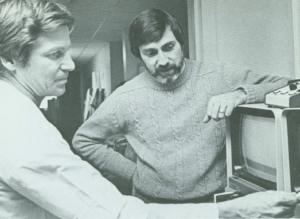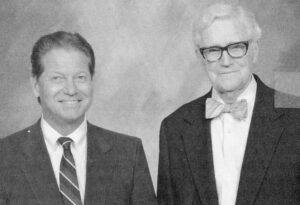Although Joseph Sackett, MD stepped down as chair of the University of Wisconsin Department of Radiology 30 years ago, his impact continues to be felt throughout the field. From advancing spine imaging to transforming the department’s structure and policy, Dr. Sackett’s research and leadership helped shape modern radiology in Wisconsin and beyond.
Early Leadership and Mentorship
Dr. Sackett graduated from Tulane University School of Medicine in 1966 and joined the department in 1974. He was the first radiologist in North America to publish a pivotal study demonstrating the safety and efficacy of metrizamide as a contrast agent for spine imaging in 1977. His research marked a significant improvement over oil-based agents, and today’s metrizamide techniques are still informed by his findings.

In the 1970s, Dr. Sackett assisted colleague Charles Mistretta, PhD in developing digital subtraction angiography (DSA), even volunteering himself as a test subject. The procedure went smoothly, aside from the contrast solution giving Dr. Sackett hives, which he shrugged off when recalling the incident.
“It was not a major reaction,” he said.
Despite the minor allergic episode, their work paid off. Today, DSA remains a vital medical imaging technique for visualizing blood vessels. A 2019 article from the journal Stroke hailed the procedure as the “current gold standard for confirming aneurysmal obliteration.”
Dr. Sackett’s collaborative leadership emerged early. He served as vice chair under Francis Ruzicka, MD who led the institution from 1976 to 1981. That partnership prepared Dr. Sackett to succeed Dr. Ruzicka as department chair.
“I worked closely with him,” Dr. Sackett said. “There weren’t any major secrets.”
Dr. Sackett also served as a mentor to Patrick Turski, MD who completed his internship and residency at UW–Madison. Dr. Sackett introduced Dr. Turski to the field of radiology and convinced him to pursue it as a career. In 1981, Dr. Turski joined the faculty, becoming chief of MRI in 1986, chief of the Section of Neuroradiology in 1993 and eventually replacing Dr. Sackett as the department chair in 1995, a full-circle moment.
“He’s an outstanding individual,” Dr. Sackett reflected on his successor. “I’m pleased he was willing to step in as chair when I retired.”
Advancing Resident Policies

During Dr. Sackett’s career, more women were slowly joining the field of radiology. According to an American College of Radiology article, only 5.3% of radiologists were women in 1970, gradually increasing to 14% in 1995 when Dr. Sackett stepped down from his leadership role. The rise in female radiologists and trainees inspired many institutions to develop more inclusive cultures.
Shortly after his appointment as chair, a high-performing female resident approached Dr. Sackett, requesting time off to manage morning sickness and stress during her pregnancy. At the time, the residency program lacked a pregnancy policy, adhering to the Board of Radiology’s 6-week annual leave limit. Recognizing the gap, Dr. Sackett and faculty members established the first departmental pregnancy policy, granting up to four weeks of paid maternity leave for residents.
Soon after, male residents and staff requested leave to support their partners during childbirth. Dr. Sackett recommended one week of paid paternity leave, provided the service chief resident cleared it. These early policy changes reflected Dr. Sackett’s philosophy of supporting trainees as they pursued their personal and career goals, even if they went against contemporary recommendations.
“These policies do not deal with the broader issue of how a resident-in-training or a junior faculty member can be a mother and spouse, do justice to the training program and remain academically productive,” Dr. Sackett wrote in a 1987 Investigative Radiology article. “I know this opposes the position of some national organizations in radiology, but I believe we must be flexible in dealing with individual trainees and junior faculty.”
In the same article, he described an innovative part-time training arrangement for a female resident balancing child care while completing the residency program. Though the position extended the resident’s training, she wouldn’t have to sacrifice her career for motherhood.
New Technologies and Partnerships
Alongside policy changes, Dr. Sackett recognized the need to modernize the department’s technological capabilities. Though MRI technology was in its infancy when he became chair, he quickly positioned the institution to lead in this emerging field.
In 1984, the department began a collaborative research program with General Electric Medical Systems (now GE HealthCare) and installed the first MRI machine on campus. Previously, researchers traveled to GE’s facility in Waukesha, Wisconsin to access equipment.
Today, the department has access to over 20 MRI scanners for research, and its longstanding relationship with GE HealthCare has generated over 100 patents. In November 2023, GE HealthCare and UW–Madison announced a 10-year strategic collaboration to continue to advance medical imaging and improve patient care.
Restructuring for Growth
In 1981, the department comprised five subdivisions: radiotherapy, medical physics, nuclear medicine, radiobiology and diagnosis. During his tenure, radiotherapy joined the Department of Human Oncology, medical physics became a separate department and radiobiology shifted to the Clinical Cancer Center (now UW Carbone Cancer Center).

During this time, the advances in medical imaging technology necessitated additional subspecialities. By 1995, the department expanded to ten major sections, including skeletal, angio/interventional, neuroradiology, pediatrics, mammography, chest, VA radiology, nuclear medicine, MRI and body imaging.
Today’s 14 sections include most of those created in the Sackett era, with some renamed to accommodate changes in medical terminology or additional subspecialties. Recent additions include the Section of Emergency Radiology and Clinical Imaging Physics. Current Chair Scott Reeder, MD, PhD noted the latter “demonstrates the continued legacy and commitment of UW–Madison to the high standards in medical imaging required to provide optimal patient care.”
Dr. Sackett’s incredible work as a faculty member and chair lives on through the department’s legacy while his personal legacy is most visible in the Joseph F. Sackett Professorship in Radiology created in his honor to support the Section of Neuroradiology chief. Recipients of the professorship include inaugural honoree Howard Rowley, MD and the current holder, Tabassum (Tabby) Kennedy, MD.
As the department approaches its centennial in 2027, Dr. Sackett’s words to present and future members remain simple.
“Just carry on and do as well as they have.”